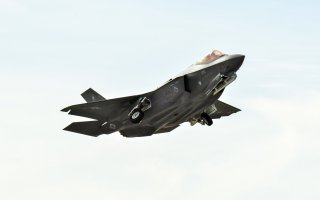The F-35 Is Proving Its Mettle in the Middle East
Airmen from the 388th Fighter Wing at Hill Air Force Base have been putting their F-35A Lightning II Joint Strike Fighters to the test.
Here's What You Need to Know: The F-35 stealth fighter has continually demonstrated its flexibility in the Middle East.
For the past sixteen months the airmen from the 388th Fighter Wing at Hill Air Force Base have been putting their F-35A Lightning II Joint Strike Fighters to the test, and have continued to find ways to improve the capability of America's most advanced fifth-generation fighter aircraft.
Each of the wing's three squadrons, operating with reservists from the 419th Fighter Wing, have been deployed in support of the Air Force Central Command mission at Al Dhafra Air Base, United Arab Emirates.
The Wing's 4th Fighter Squadron deployed in April 2019 and was the first to conduct operations with the F-35A; while the 34th Fighter Squadron deployed in October of last year—and the units returned home to Hill AFB in northern Utah in June and July respectively. The 421st Fighter Squadron is currently still deployed to the UAE.
"Our Airmen continue to carry out the combat mission the Air Force asks of us," said Col. Steven Behmer, 388th Fighter Wing commander. "Not only that, but they are truly on the leading edge of developing how our service employs this very capable fighter, now and in the future."
The F-35A is the Air Force's version of the Joint Strike Fighter, and is a conventional takeoff and landing fighter that entered service in 2016.
After the squadrons arrived in Al Dhafra Air Base they took part in their first combat sortie within twenty-four hours, and not a single sortie was lost due to maintenance issues over the course of the next eight months the United States Air Force reported.
"During this deployment we demonstrated to senior leaders in theater what we've known to be true: the F-35 is formidable, it is adaptable and it is less needy in terms of maintenance than people may expect," added Capt. Susan McLeod, officer in charge of the 34th Aircraft Maintenance Unit.
The squadron further demonstrated the flexibility of the multi-role F-35, and on a given day, the fighters' pilots performed strafing runs on close air support missions, and maritime escorts for U.S. Navy carrier strike groups.
"We proved the F-35 can carry out a variety of missions," Lt. Col. Aaron Cavazos, 34th FS commander. "While the F-35 is just another asset to be tasked, there are some other cool fifth-generation capabilities that we bring to the table and have to be used the correct way. We can go take away a chunk of airspace at a moment;s notice and give it back at a later point if we want to. It was a pretty neat role to be able to support AFCENT and we're doing our best to communicate to combatant commands exactly what we can offer them."
The deployment of the F-35As to Al Dhafra Air Base is notable in that the United Arab Emirates has been reportedly seeking for years to purchase the Joint Strike Fighter. Currently, Israel is the only country in the Middle East with the stealthy F-35. Israel's two squadrons of F-35s, the second of which became operational in August 2020, regularly practice with U.S. F-35s that fly in from Central Command’s base at Al-Dhafra in the UAE.
Weapon System Evaluation Program
Hill Air Force Base's Fighter Weapons Squadron has also been conducting an in-depth weapons evaluation known as Combat Hammer at the AFB and at the Utah Test and Training Range. The evaluation was part of the Air Force's Weapons System Evaluation Program. It involved maintainers and air crews who built, loaded and employed weapons from the base's F-35As from Hill as well as Nellis AFB. It also included B-1s from Ellsworth AFB, South Dakota; and MQ-9s from Creech AFB, Nevada.
The 86th FWS is the single Department of Defense agency charged with conducting predictive battle damage analysis of precision guided munitions using operational weapons, aircraft, maintenance personnel and aircrew.
"During Combat Hammer, we are tasked to evaluate the reliability, maintainability, suitability, accuracy, and readiness of combat weapons systems against realistic threats and targets," said Master Sgt. George Bermudez, superintendent of WESP at the 86 FWS. "This requires an end-to-end evaluation of the total fielded integrated weapons system – from the manufacturer delivery to the effect on the target."
Peter Suciu is a Michigan-based writer who has contributed to more than four dozen magazines, newspapers and websites. He is the author of several books on military headgear including A Gallery of Military Headdress, which is available on Amazon.com.
This article first appeared in August 2020.
Image: U.S. Air Force photo/R. Nial Bradshaw

